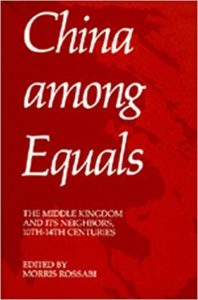“Of interest mainly to specialists” is one of those phrases that reviewers often use to suggest, however gently, that a book is terribly dull and that no one outside of a select audience should read it. With a subtitle that reads The Middle Kingdom and its Neighbors, 10th-14th Centuries, China Among Equals is clearly aimed at a small audience, never mind that it was published nearly 35 years ago (arising from a conference held five years before that), and the scholarship among said specialists has very likely moved well past the ground staked out by this book. And yet, I am finding it full of geeky pleasures. In its densely footnoted way, China Among Equals is fascinating.
For all that it is about polities a thousand years in the past, the book is also not irrelevant to larger and more contemporary concerns. As Morris Rossabi writes in his introduction, “Westerners in the nineteenth and twentieth centuries were fascinated by the conduct of traditional Chinese foreign relations. … They also assumed that the Chinese dynasties had uniformly and rigidly applied this system of foreign relations from the Han dynasty (206 B.C. – A.D. 220) on, an assumption that is challenged by the essay in this book.” (p. 1) Under this system, the Chinese “devised a scheme which demanded acknowledgement of their superiority.” (p. 2) Foreigners could only have relations with China if they first bowed to China as the superior power and paid tribute to the emperor. “The conventional wisdom is that China preserved this system from the second century B.C. until the middle of the nineteenth century,” (p. 4) when Britain’s ambassador famously refused to prostrate himself before the Son of Heaven and other European powers rejected the Chinese system.
China Among Equals describes and documents a period of several centuries during which the so-called Chinese world order did not hold sway in East Asia. “The Sung (960–1279), the principle dynasty during this era, was flexible in its dealings with foreigners.” (p. 4) Sung officials dealt with neighboring rulers in a variety of different ways, up to and including recognizing some of them as peers. During this period, Chinese merchants also traded across much of Southeast Asia, leading to settlements in the region that are still there today. They competed with Arab traders who crossed the Indian Ocean with the monsoon; Chinese shipbuilders adopted technology that was developed outside of China, and over this period their ships changed from being only suitable for coastal waters to outstripping Arab vessels in seaworthiness. All of these aspects undermine the notion that China regarded itself as completely self-sufficient, the center of the world. To the extent that the traditional view shapes current thinking either inside or about China, showing that it was not universally true is relevant to dealing with twenty-first century China. The pragmatism and variety shown by the examples in this volume are reminders, as if any were needed, to look behind national mythologies, especially those that claim to stretch over thousands of years.
The book is also chock full of implied stories. “Especially for the tenth and eleventh centuries, the Koryo-sa (virtually our only Korean source) is thin in its coverage, owing to the destruction of the dynastic archives in Kaesong in 1011 by Khitan invaders.” (p. 151) Doesn’t that sound like an excellent fantasy novel? Or at least an episode of a good TV show? “The nativist-irredentist movement that acquired momentum in the late 1120s was led by the monk Myoch’ong, who was able to gain influence over the young king Injong by virtue of his thaumaturgic reputation.” (p. 162) I want the movie rights! Other essays detail the comings and goings of missions from one capital to another, with side notes on who tried to get ahead, who got rich in notionally prohibited private trade alongside the official embassy, and who got busted down in the ranks for misbehaving while abroad. People being people, in other words, and I find it fascinating. Not least that records were kept in enough detail to read about it halfway around the world a thousand years later in a language related to precisely none of those spoken at the events in question.
The contributors came from the US, West Germany, Italy, Australia, and Japan. An invitee from Leningrad was unable to attend the initial conference, but his paper helped the editor in revising the others. The essays in the book were written just as Deng Xiaoping was consolidating power in China, at a time when the country was far less open than it is today. The book itself is thus a bit of a historical artifact.
I wouldn’t want to have a steady diet of books like China Among Equals, but it shows why it can be a good idea, every now and then, to dip into things that are mainly of interest to specialists.

